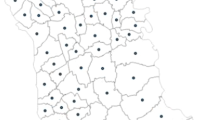Abstract
Districting problems are of high importance in many different fields. Multiple criteria models seem a more adequate representation of districting problems in real-world situations. Real-life decision situations are by their very nature multidimensional. This paper deals with the problem of partitioning a territory into “homogeneous” zones. Each zone is composed of a set of elementary territorial units. A district map is formed by partitioning the set of elementary units into connected zones without inclusions. When multiple criteria are considered, the problem of enumerating all the efficient solutions for such a model is known as being NP-hard, which is why we decided to avoid using exact methods to solve large-size instances. In this paper, we propose a new method to approximate the Pareto front based on an evolutionary algorithm with local search. The algorithm presents a new solution representation and the crossover/mutation operators. Its main features are the following: it deals with multiple criteria; it allows to solve large-size instances in a reasonable CPU time and generates high quality solutions. The algorithm was applied to a real-world problem, that of the Paris region public transportation. Results will be used for a discussion about the reform of its current pricing system.
Similar content being viewed by others
References
Bergey, P. K., Ragsdale, C. T., & Hoskote, M. (2003a). A decision support system for the electrical power districting problem. Decision Support Systems, 36, 1–17.
Bergey, P. K., Ragsdale, C. T., & Hoskote, M. (2003b). A simulated annealing genetic algorithm for the electrical power districting problem. Annals of Operations Research, 121, 33–55.
Bourjolly, J. M., Laporte, G., & Rousseau, J. M. (1981). Découpage electoral automatisé: application á l’Île de Montréal. INFOR: Information Systems and Operational Research, 19, 113–124.
Bozkaya, B., Erkut, E., & Laporte, G. (2003). A tabu search heuristic and adaptive memory procedure for political districting. European Journal of Operational Research, 144, 12–26.
Chance, C. W. (1965). Representation and reapportionment. Political studies: number 2, Dept. of Political Science, Ohio State University, Columbus.
Cortona, P. G., Manzi, C., Pennisi, A., Ricca, F., & Simeone, B. (1999). Evaluation and optimization of electoral systems. SIAM monographs on discrete mathematics and applications. Philadelphia: SIAM.
D’Amico, S. J., Wang, S. J., Batta, R., & Rump, C. M. (2002). A simulated annealing approach to police district design. Computers & Operations Research, 29, 667–684.
Deckro, R. F. (1979). Multiple objective districting: a general heuristic approach using multiple criteria. Operational Research Quarterly, 28, 953–961.
Easingwood, C. (1973). A heuristic approach to selecting sales regions and territories. Operational Research Quarterly, 24(4), 527–534.
Ferland, J. A., & Guénette, G. (1990). Decision support system for the school districting problem. Operations Research, 38, 15–21.
Fleischmann, B., & Paraschis, J. N. (1988). Solving a large scale districting problem: a case report. Computers & Operations Research, 15(6), 521–533.
Forrest, E. (1964). Apportionment by computer. American Behavioral Scientist, 7, 23–25.
Garfinkel, R. S., & Nemhauser, G. L. (1970). Optimal political districting by implicit enumeration techniques. Management Science, 16(8), 495–508.
Hess, S. W., & Samuels, S. A. (1971). Experiences with a sales districting model: criteria and implementation. Management Science, 18(4), 41–54.
Hess, S. W., Siegfeldt, J. B., Whelan, J. N., & Zitlau, P. A. (1965). Nonpartisan political redistricting by computer. Operations Research, 13(6), 998–1006.
Hojati, M. (1996). Optimal political districting. Computers & Operations Research, 23(12), 1147–1161.
Mehrotra, A. (1992). Constrained graph. PhD thesis, Georgia Institute of Technology.
Mehrotra, A., Johnson, E. L., & Nemhauser, G. L. (1998). An optimization based heuristic for political districting. Management Science, 44(8), 1100–1114.
Mousseau, V., Roy, B., & Sommerlatt, I. (2001). Development of a decision aiding tool for the evolution of public transport ticket pricing in the Paris region. In M. Paruccini, A. Colorni & B. Roy (Eds.), A-MCD-A aide multicritère à la décision—multiple criteria decision aiding (pp. 213–230). Luxembourg: Joint Research Center, European Commission.
Muyldermans, L., Cattrysse, D., Oudheusden, D. V., & Lotan, T. (2002). Districting for salt spreading operations. European Journal of Operational Research, 139, 521–532.
Nygreen, B. (1988). European assembly constituencies for wales. Comparing of methods for solving a political districting problem. Mathematical Programming, 42, 159–169.
Park, K., Lee, K., Park, S., & Lee, H. (2000). Telecommunication node clustering with node compatibility and network survivability requirements. Management Science, 46(3), 363–374.
Preux, P., & Talbi, E. G. (1999). Towards hybrid evolutionary algorithms. International Transactions in Operational Research, 6, 557–570.
Reeves, C. R. (1997). Genetic algorithms for the operations researcher. INFORMS Journal on Computing, 9(3), 231–250.
Ross, P. (1997). What are genetic algorithms good at? INFORMS Journal on Computing, 9(3), 260–262.
Shanker, R. J., Turner, R. E., & Zoltners, A. A. (1975). Sales territory design: an integrated approach. Management Science, 22(3), 309–320.
Srinivas, N., & Deb, K. (1995). Multiobjective optimization using nondominated sorting genetic algorithms. Evolutionary Computation, 2/3, 221–248.
Steuer, R. E. (1986). Multiple criteria optimization: theory, computation and application. New York: Wiley.
Tavares-Pereira, F., Figueira, J., Mousseau, V., & Roy, B. (2004). Multiple criteria districting problems, models, algorithms, and applications: the public transportation Paris region pricing system. Research report no. 21/2004, INESC—Coimbra, Portugal.
Van Veldhuizen, D. A. (1999). Multiobjective evolutionary algorithms: classifications, analyses, and new innovations. PhD thesis, Department of Electrical and Computer Engineering, Graduate School of Engineering, Air Force Institute of Technology, Wright-Patterson AFB, Ohio.
Vickrey, W. (1961). On the preventions of gerrymandering. Political Science Quarterly, 76(1), 105–110.
Zoltners, A. A., & Sinha, P. (1983). Sales territory alignment: a review and model. Management Science, 29(3), 1237–1256.
Author information
Authors and Affiliations
Corresponding author
Rights and permissions
About this article
Cite this article
Tavares-Pereira, F., Figueira, J.R., Mousseau, V. et al. Multiple criteria districting problems. Ann Oper Res 154, 69–92 (2007). https://doi.org/10.1007/s10479-007-0181-5
Published:
Issue Date:
DOI: https://doi.org/10.1007/s10479-007-0181-5




